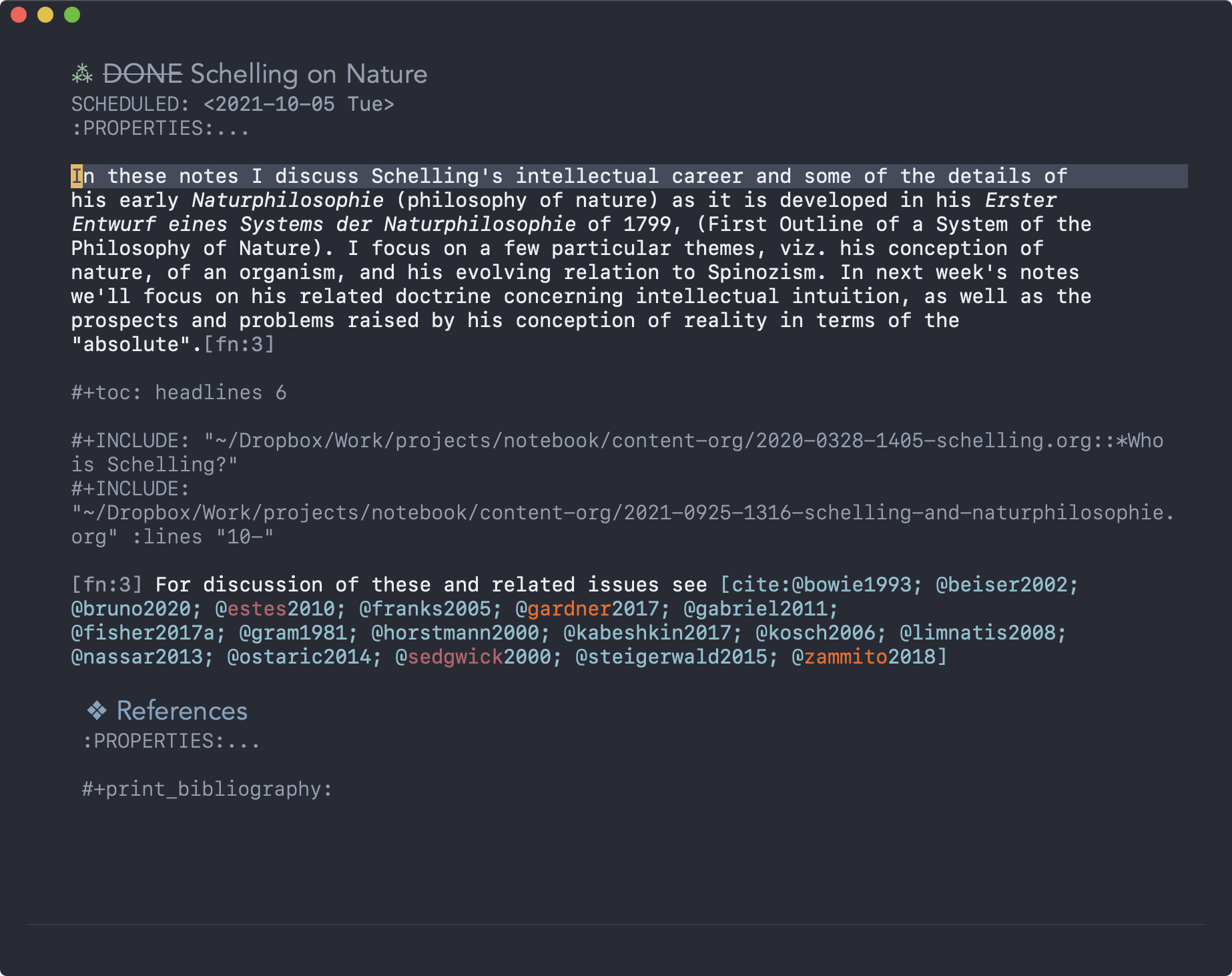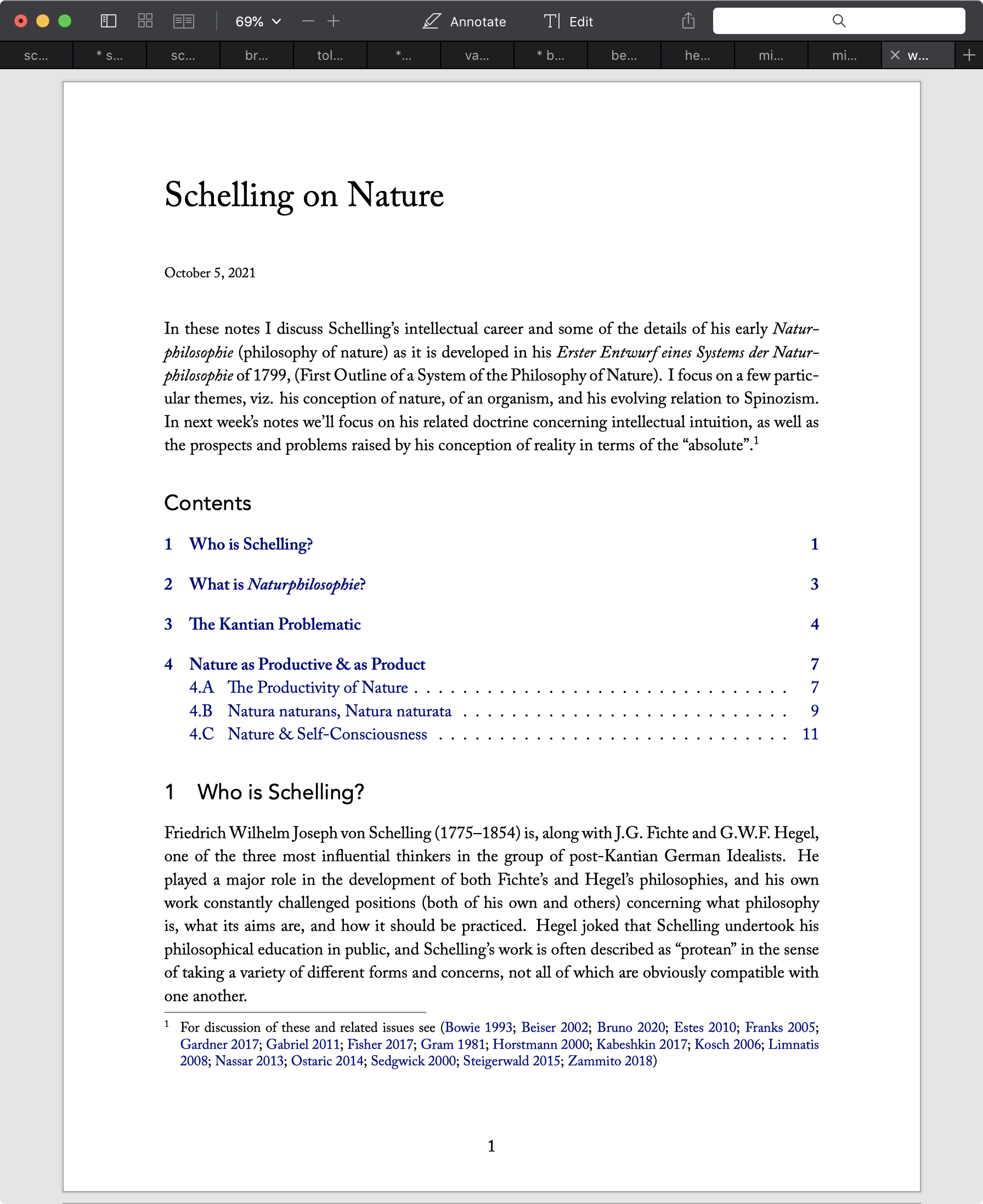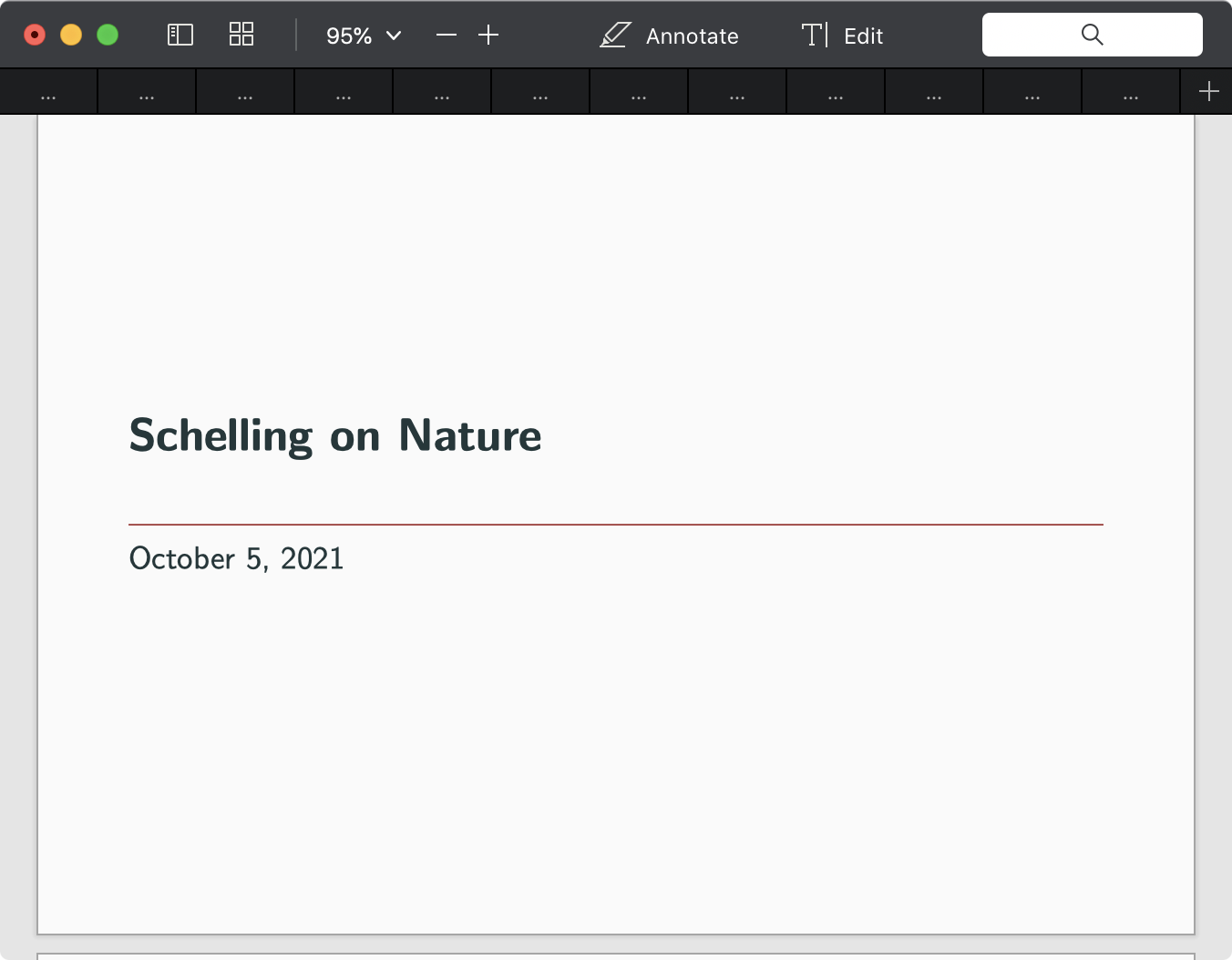I’ve recently created some functions in emacs to make exporting notes, slides, and handouts somewhat easier. I do all this using org-mode. I figure there are at least a few other people who might find this workflow of interest so I though I would document it here (it will also serve as a document of how all this works in case I forget in the future).
I want to be able to turn something like the following:

Into a nice looking set of PDF notes like this:

Or a set of slides like this:

Notes
Basically, I want to be able to export from a file or an org-mode tree in a few
different ways. First, I might want to export from my org files a set of notes that
I’ll use during lecture and share with students. I use org-roam to keep all my notes
and I have some custom functions (adapted from here) to search them. I’ll put all
these together in an org file using the #+INCLUDE: directive (see here). This lets me
collect notes from a bunch of different places into one set. I can select specific
files, specific headings, even specific lines. I’ll then export using one of the
following functions (depending on context):
(defun cpm/org-export-pdf-notes ()
"Export subtree of notes to PDF file. Note uses a distinctive quote style."
(interactive)
(let ((org-latex-default-quote-environment "quote-b"))
(org-narrow-to-subtree)
(save-excursion
(goto-char (point-min))
(org-latex-export-to-pdf t t nil nil '(:latex-class "org-notes")))
(widen)))
(defun cpm/org-export--file-pdf-notes ()
"Export file notes to PDF file. Note uses a distinctive quote style."
(interactive)
(let ((org-latex-default-quote-environment "quote-b"))
(save-excursion
(goto-char (point-min))
(org-latex-export-to-pdf t nil nil nil '(:latex-class "org-notes")))))These functions require that you create the following custom org-latex class:
;; Export org to a nice looking PDF file
(with-eval-after-load 'ox-latex
(add-to-list 'org-latex-classes
'("org-notes"
"\\documentclass[12pt]{article}
[NO-DEFAULT-PACKAGES]
[EXTRA]
\\input{/Users/roambot/.emacs.d/.local/custom-org-latex-classes/notes-setup-file.tex}"
("\\section{%s}" . "\\section*{%s}")
("\\subsection{%s}" . "\\subsection*{%s}")
("\\subsubsection{%s}" . "\\subsubsection*{%s}")
("\\paragraph{%s}" . "\\paragraph*{%s}")
("\\subparagraph{%s}" . "\\subparagraph*{%s}"))))The export functions run an asynchronous process to produce a nice looking PDF of the relevant notes. This does also require a specific set of latex packages that I set in another file I call “notes-setup-file.tex”. Note that these classes use a custom quote environment (“quote-b”) to show quoted passages with a left-side bar and with a slightly shaded background. I’ll put a link to the tex files where all of this is specified at the end of this post.
Slides & Handouts
The other thing I often need to do is create slides for a lecture or talk, as well as a handout. I like beamer with a custom version of the Metropolis theme. I don’t want to have to create separate files for the slides and for the handout. I also don’t want to just give a handout that is a set of pictures of the slides. Terrible! So here’s what I do instead.
First, I have a set of custom classes:
;; Presentation slides (with notes)
(with-eval-after-load 'ox-latex
(add-to-list 'org-latex-classes
'("beamer-presentation"
"\\documentclass[presentation]{beamer}
[NO-DEFAULT-PACKAGES]
[PACKAGES]
\\usepackage{pgfpages}
[EXTRA]
\\setbeameroption{show notes on second screen=right}
\\setbeamertemplate{note page}{\\pagecolor{yellow!5}\\insertnote}
\\input{/Users/roambot/.emacs.d/.local/custom-org-latex-classes/unl-beamer-preamble.tex}"
("\\section{%s}" . "\\section*{%s}")
("\\subsection{%s}" . "\\subsection*{%s}")
("\\subsubsection{%s}" . "\\subsubsection*{%s}"))))
;; Making handouts for slides that don't just look like slides
(with-eval-after-load 'ox-latex
(add-to-list 'org-latex-classes
'("beamer-handout"
"\\documentclass[12pt]{article}
[NO-DEFAULT-PACKAGES]
[EXTRA]
\\input{/Users/roambot/.emacs.d/.local/custom-org-latex-classes/handout-setup-file.tex}"
("\\section{%s}" . "\\section*{%s}")
("\\subsection{%s}" . "\\subsection*{%s}")
("\\subsubsection{%s}" . "\\subsubsection*{%s}")
("\\paragraph{%s}" . "\\paragraph*{%s}")
("\\subparagraph{%s}" . "\\subparagraph*{%s}"))))I also like to have the slides be primarily texts or main ideas, while my notes are in a separate area, which will show up on the handout but not the slides. I use a src enviroment called “notes” for this and the following code for filtering everything correctly on export.
;; Originally used for exporting notes in reveal.js
;; See
;; https://joonro.github.io/Org-Coursepack/Lectures/04%20Creating%20Content%20for%20Slides%20and%20Handouts.html#speaker-notes
(defun string/starts-with (string prefix)
"Return t if STRING starts with prefix."
(and (string-match (rx-to-string `(: bos ,prefix) t) string) t))
(defun my/process-NOTES-blocks (text backend info)
"Filter NOTES special blocks in export."
(cond
((eq backend 'rst)
(if (string/starts-with text ".. NOTES::") ""))
((eq backend 'html)
(if (string/starts-with text "<div class=\"NOTES\">") ""))
((eq backend 'beamer)
(let ((text (replace-regexp-in-string "\\\\begin{NOTES}" "\\\\note{" text)))
(replace-regexp-in-string "\\\\end{NOTES}" "}" text)))
))
(eval-after-load 'ox '(add-to-list
'org-export-filter-special-block-functions
'my/process-NOTES-blocks))Then I have a set of functions for exporting the relevant files asynchronously.
;; Org export to slides w/notes
(defun cpm/org-export-beamer-presentation ()
(interactive)
(let ((org-export-exclude-tags '("handout")))
(save-excursion
(goto-char (point-min))
(org-beamer-export-to-pdf nil t nil nil '(:latex-class "beamer-presentation")))))
;; I got the tag based selective export idea from J Kitchin
;; https://kitchingroup.cheme.cmu.edu/blog/2013/12/08/Selectively-exporting-headlines-in-org-mode/
(defun cpm/org-export--file-beamer-presentation ()
(interactive)
(let ((org-export-exclude-tags '("handout")))
(save-excursion
(goto-char (point-min))
(org-beamer-export-to-pdf t nil nil nil '(:latex-class "beamer-presentation")))))
;; Org export file to handout
(defun cpm/org-export-beamer-handout ()
"Export subtree content to PDF handout. Handout uses a distinctive quote style."
(interactive)
(let ((org-latex-default-quote-environment "quote-b")
(org-export-exclude-tags '("slides")))
(org-narrow-to-subtree)
(save-excursion
(goto-char (point-min))
(org-latex-export-to-pdf t t nil nil '(:latex-class "beamer-handout")))
(widen)))
(defun cpm/org-export--file-beamer-handout ()
"Export file content to PDF handout. Handout uses a distinctive quote style."
(interactive)
(let ((org-latex-default-quote-environment "quote-b")
(org-export-exclude-tags '("slides")))
(save-excursion
(goto-char (point-min))
(org-latex-export-to-pdf t nil nil nil '(:latex-class "beamer-handout")))))The nice thing about this is I can use a single file and export a nice looking set of slides and a good handout, where the handout can also include extra notes or passages via the tag filter on export.
For a look at the org-latex-classes you can check out the github repository. You can
also look at the above functions as they appear in my dotfiles. And if you end up
using fonts like the ones that I use above rather than something like computer
modern, you’ll have to remember to set xelatex as your processor. This means putting
#+LATEX_COMPILER: xelatex at the top of your org file or related setupfile.